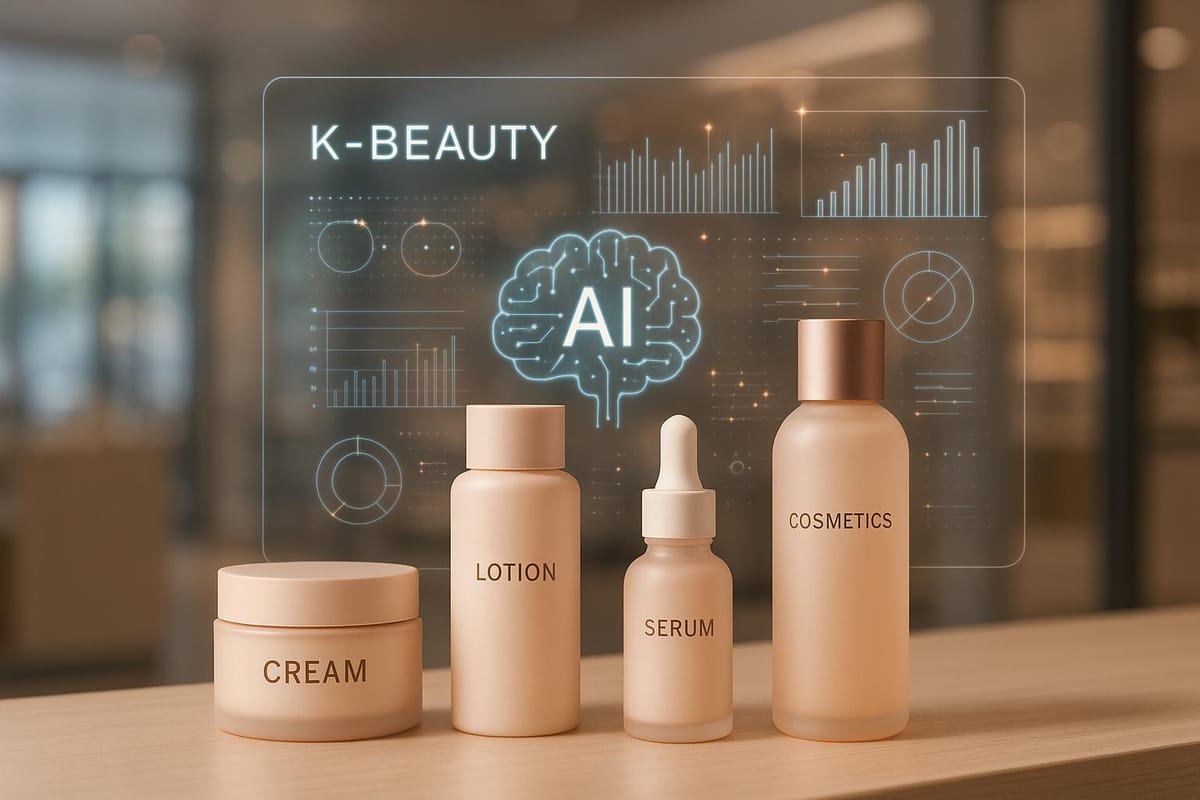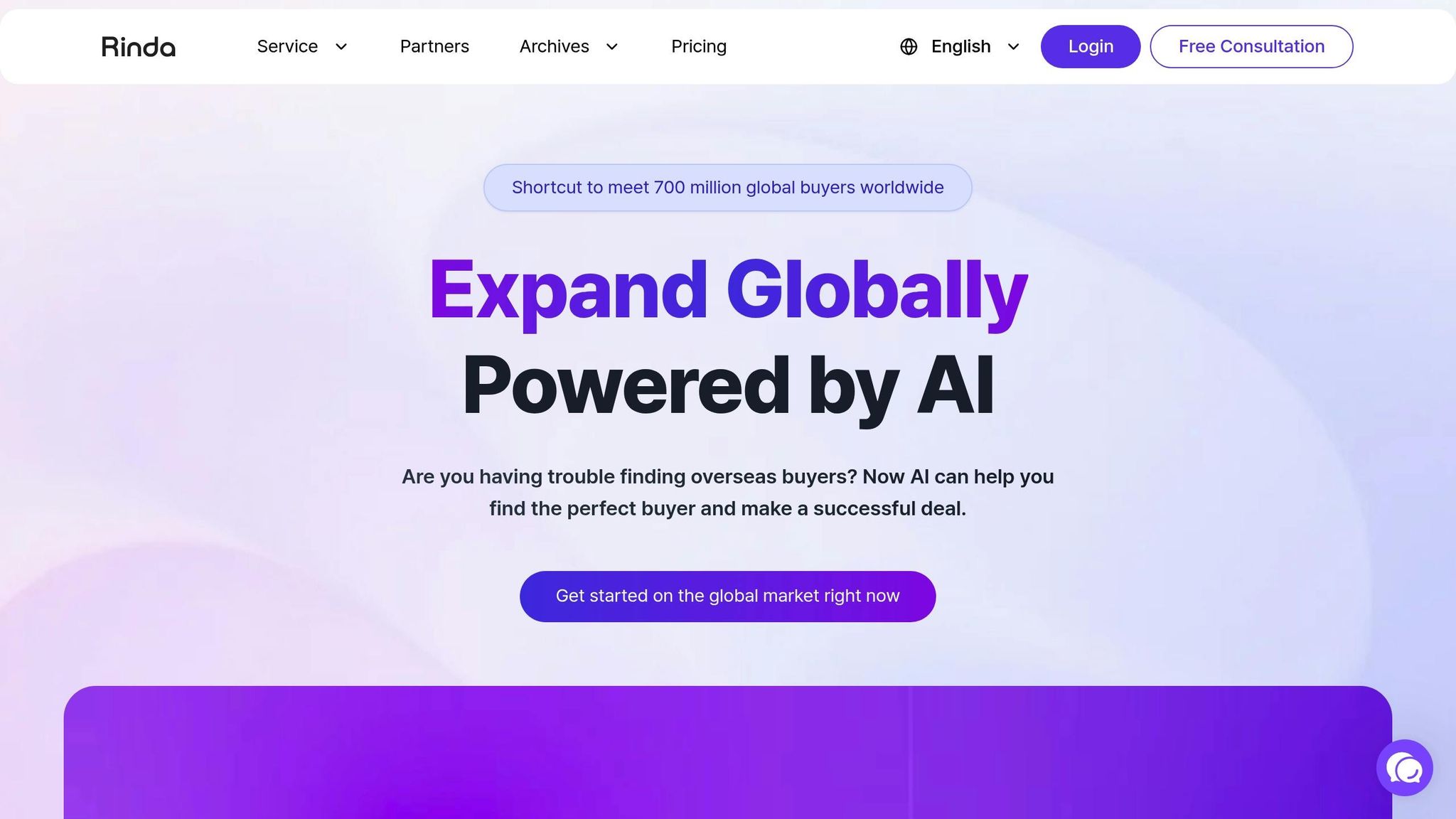Beauty Industry's Digital Revolution: How K-Beauty and AI Are Reshaping Global Cosmetics Sales
Explore how K-Beauty and AI are transforming the global beauty market, emphasizing sustainability and personalized consumer experiences.

By 2025, artificial intelligence (AI) and Korean beauty (K-Beauty) are reshaping the $571 billion global beauty market. According to Circana's 2024 data, the U.S. prestige beauty sector is rebounding, reflecting how digital tools and consumer preferences are redefining product innovation and sales strategies. Meanwhile, sustainability is no longer optional, as buyers prioritize eco-conscious practices alongside high-performing products.
In this article, you'll discover:
- How K-Beauty’s product innovation is influencing global brands, from hybrid formulations to ingredient transparency.
- The role of AI in personalizing beauty sales, improving customer experiences, and reducing operational inefficiencies.
- Why sustainability is driving beauty industry decisions, with AI tools optimizing supply chains and cutting waste.
For businesses, these shifts mean opportunities to refine customer engagement, streamline operations, and align with evolving consumer values. As digitalization accelerates, brands that leverage these trends can unlock new growth potential in a competitive landscape.
Read on to explore how these forces are shaping the future of beauty and what steps your business can take to stay ahead.
South Korean AI robot customises cosmetics to skin tone
K-Beauty's Growing Global Market Share
K-Beauty has transitioned from being a regional phenomenon to a global force, reshaping beauty standards and driving forward-thinking product innovation. Its recent expansion in the U.S. reflects Korea's commitment to research and development, multifunctional product design, and educating consumers.
The rapid rise of K-Beauty isn’t just about eye-catching packaging or social media buzz. What truly sets it apart is its proactive approach - creating and anticipating consumer desires rather than merely responding to trends. From cushion compacts to essence-based skincare routines, Korean brands have consistently introduced concepts that evolve into industry benchmarks. This wave of innovation fuels not only new product launches but also inspires global competitors to adapt and innovate.
New Ingredients and Multi-Purpose Products
K-Beauty has revolutionized product development by introducing groundbreaking ingredients and hybrid formulations. Companies like Amorepacific and LG Household & Health Care have invested heavily in research, leading to the use of unique components such as snail secretion filtrate, bee venom, and fermented botanicals.
Hybrid products blur the lines between skincare and makeup, offering multifunctional solutions. Think tinted moisturizers with SPF, lip tints infused with hydrating serums, or BB creams that combine anti-aging benefits with coverage. These products cater to consumers who want streamlined routines without sacrificing performance.
Korean brands have also pioneered the concept of “skin-first makeup,” where cosmetics are enriched with skincare benefits. Cushion foundations infused with hyaluronic acid or lipsticks containing ceramides are prime examples of how K-Beauty combines aesthetic appeal with skin health, offering products that do more than just enhance appearance.
Global Brands Copy K-Beauty Methods
K-Beauty’s influence is evident as global brands adopt its strategies in product development, marketing, and consumer interaction. Companies like L’Oréal, Unilever, and Procter & Gamble have launched products inspired by K-Beauty trends, from glass-skin skincare regimens to gradient lip colors rooted in Korean makeup techniques.
Many Western brands are also collaborating with Korean manufacturers to tap into their advanced production expertise and access to unique ingredients. Beyond product innovation, international companies are embracing practices like ingredient transparency, offering detailed application guides, and promoting long-term skin health over quick fixes. These shifts highlight how K-Beauty has sparked a digital and scientific transformation across the global beauty industry.
AI-Powered Personalization in Beauty
AI is reshaping the beauty industry by delivering personalized experiences and simplifying global sales. By aligning products with individual consumer needs, AI reduces the overwhelm of too many choices, creating a more seamless shopping journey.
This shift is transforming how customers engage with beauty products while redefining global sales strategies. It enables tailored recommendations, smoother interactions, and effective communication across diverse markets.
AI Product Recommendations
AI-powered tools analyze customer preferences, browsing history, and even skin types to suggest products that genuinely fit individual needs. These systems not only improve customer satisfaction but also increase the likelihood of purchase, as shoppers feel understood and catered to.
Automated Sales and Multi-Language Support
AI enhances sales processes by automating repetitive tasks and providing support in multiple languages. This capability ensures smooth communication with international buyers, breaking down language barriers and opening doors to new markets.
RINDA: Changing Global Sales Methods

RINDA takes these AI advancements a step further, revolutionizing global sales in the beauty industry. Designed specifically for beauty and cosmetics brands, this AI-driven solution automates critical sales tasks such as identifying overseas buyers, crafting personalized outreach, and analyzing performance metrics.
What sets RINDA apart is its ability to verify buyer interest in real time and support communication in over 20 languages. This makes it a powerful tool for beauty brands aiming to expand internationally, combining efficiency with a digital-first approach to global sales. By leveraging RINDA, beauty businesses can navigate the complexities of international markets with greater ease and precision, reflecting the industry's broader digital transformation.
Multi-Purpose and Science-Based Product Development
The beauty industry is undergoing a major transformation, with a growing focus on products that serve multiple purposes and are grounded in solid scientific research. This shift mirrors the heightened expectations of consumers, who now prioritize transparency, effectiveness, and value in their beauty routines. Shoppers are looking for products that can address several skincare or cosmetic needs in a single formulation, saving time without sacrificing results. This trend not only represents advancements in product development but also encourages clearer communication within the industry.
The blending of cosmetics and skincare has introduced entirely new product categories that simplify routines while delivering noticeable outcomes. Scientific validation has become a cornerstone of these innovations, as brands heavily invest in research and development to back their multi-functional claims. This approach not only instills confidence in consumers but also supports premium pricing in an increasingly competitive market.
Consumer Demand for Effective and Transparent Products
In line with trends like AI-driven personalization and eco-consciousness, today’s beauty consumers demand products that are both scientifically validated and transparent about their benefits. Shoppers want to know exactly what goes into their products, how they’re made, and whether they deliver on their promises. This push for informed choices has driven brands to prioritize clear communication and evidence-based results.
The wellness movement has also reshaped beauty buying habits, with consumers gravitating toward products that reflect their health-focused lifestyles. Clean beauty - free from ingredients like parabens, sulfates, and synthetic fragrances - has moved from niche to mainstream. However, consumers are no longer satisfied with vague "clean" claims. They expect proof, backed by science, rather than marketing slogans.
Transparency around ingredients is now a must. Many brands are stepping up by detailing the concentration of active ingredients and explaining their benefits. This openness extends to sourcing practices, as consumers increasingly value ethically sourced ingredients and environmentally friendly production methods.
The demand for proven results has also propelled the popularity of science-backed ingredients such as retinoids, peptides, and various acids. Shoppers are willing to pay more for products that deliver noticeable improvements, even if it means committing to a longer regimen to see the full effects.
Blurring the Lines Between Premium and Mass-Market Products
The divide between premium and mass-market beauty products is narrowing, thanks to innovations that benefit consumers across price points. Brands at all levels are now incorporating similar technologies and ingredients, making high-quality formulations accessible to a wider audience. This shift has redefined what consumers can expect, regardless of budget.
Mass-market brands have stepped up their game by integrating advanced delivery systems, potent active ingredients, and sleek packaging - features once exclusive to luxury products. In response, premium brands are finding new ways to justify their higher prices, such as offering unique ingredients, elevated experiences, or standout packaging, rather than relying solely on their name.
The rise of direct-to-consumer brands has further accelerated this trend. These companies often focus on specific niches, delivering high-quality solutions at competitive prices with transparent pricing structures. By targeting specific demographics or needs, they’ve managed to compete effectively with established players.
Private label and contract manufacturing have also played a role, as many luxury and mass-market products are made in the same facilities. This shared production infrastructure has leveled the playing field in terms of quality, leaving differences to be defined by ingredient choices, packaging, and marketing strategies.
The result is a more dynamic and competitive marketplace. Success now hinges on true innovation, a deep understanding of consumer needs, and delivering value. For consumers, this means access to better products at a range of price points, while brands must continuously evolve to stay relevant and maintain their edge.
Sustainability as a Core Business Focus
Sustainability has moved beyond being just a trendy term; it’s now a cornerstone of success in the beauty industry. Modern consumers, especially younger ones, expect brands to take genuine responsibility for their environmental impact. This shift reflects a growing alignment between buying decisions and personal values, where environmental considerations weigh as heavily as product performance. As the beauty industry evolves alongside the digital revolution, sustainability has become an essential part of the equation.
Today, sustainable practices are woven into every stage of operations, from sourcing raw materials to delivering products. Companies that embrace sustainability not only earn consumer trust but also foster loyalty. On the flip side, businesses that fail to adapt risk falling behind in a market increasingly focused on environmental responsibility. This new emphasis on sustainability is prompting companies to reimagine traditional business models, which once prioritized cost efficiency above all else.
Sustainability doesn’t just resonate with consumers - it enhances brand value, supports premium pricing, and deepens customer loyalty.
Eco-Friendly Packaging and Ethical Sourcing
One of the most visible shifts in the beauty industry is the move toward eco-friendly packaging. Brands are going beyond basic recycled materials, introducing refillable systems and biodegradable options that set new standards. At the same time, advancements in traceability are offering consumers greater transparency about ingredient sourcing and production processes. This level of openness strengthens a brand’s commitment to ethical practices and builds deeper trust with its audience.
Adopting sustainable strategies requires balancing environmental goals with social responsibilities. Many brands are forming partnerships with organizations specializing in ethical and environmental standards. These collaborations help create frameworks for measuring progress and communicating it effectively, transforming sustainability into a strategic asset rather than a regulatory obligation.
AI Tools Support Sustainability Goals
Artificial intelligence is playing an increasingly important role in advancing sustainability within the beauty sector. AI-powered supply chain management tools, for instance, can forecast demand with greater accuracy, reducing overproduction and minimizing waste. By analyzing patterns like seasonal trends and regional preferences, these systems also help streamline distribution networks, cutting down on energy use and emissions.
A prime example of technology supporting sustainability is RINDA’s global sales platform. With its multilingual communication capabilities, RINDA enables remote international sales efforts, reducing the need for extensive travel. This digital-first approach not only facilitates global connections but also helps lower the carbon footprint tied to traditional, travel-heavy sales methods.
Emerging AI tools are also paving the way for more efficient resource use in product development and distribution. Advanced analytics are being applied to optimize ingredient sourcing, packaging design, and manufacturing processes. These innovations aim to minimize material usage while maintaining product quality and brand integrity. This growing integration of AI signals a shift from merely meeting compliance standards to adopting forward-thinking strategies that benefit both the environment and business performance.
Traditional vs. AI-Powered Global Sales Comparison
Global sales strategies are evolving rapidly, driven by the rise of AI-powered personalization and a growing emphasis on sustainability. In the cosmetics industry, AI-driven automation is reshaping how businesses approach international sales, replacing the slow, resource-heavy methods of the past. This shift not only simplifies operations but also redefines efficiency in global sales.
Traditional sales methods involved significant investments in research, travel, and building partnerships - often with limited success. Sales teams would spend months nurturing distributor relationships without access to real-time buyer insights, which led to low conversion rates and extended sales cycles.
AI-powered platforms, on the other hand, bring precision and speed to the process. These systems analyze global trends, identify high-potential buyers, and create tailored outreach strategies in just hours. Companies adopting these tools have seen measurable improvements, including better conversion rates, shorter sales cycles, and lower operational costs.
| Aspect | Traditional Sales | AI-Powered Sales |
|---|---|---|
| Buyer Discovery | Manual research, trade shows, referrals | Real-time global analysis |
| Market Analysis | Periodic reports and consultant studies | Continuous data monitoring with predictive analytics |
| Communication | Limited language capabilities | Multilingual support |
| Personalization | Generic presentations | Customized strategies based on buyer behavior |
| Performance Tracking | Monthly or quarterly reviews | Real-time analytics and continuous optimization |
| Cost Structure | High travel, event, and personnel costs | Subscription-based model with predictable ROI |
AI-powered sales methods also support the beauty industry's push toward sustainability. Traditional approaches, which rely heavily on international travel and printed marketing materials, often come with a larger environmental footprint. In contrast, digital tools - such as RINDA's platform - enable remote collaboration and communication, significantly reducing environmental impact.
Additionally, these platforms are leveling the playing field for beauty brands of all sizes. With access to advanced market intelligence and global buyer networks, smaller companies can now compete more effectively in international markets. This fosters greater innovation and responsiveness to market demands. As AI continues to transform the beauty industry, these tools are paving the way for sustainable and competitive growth on a global scale.
The Future of Beauty in the Digital Age
The beauty industry is undergoing a transformation fueled by the convergence of K-Beauty trends, AI-driven personalization, and a growing focus on sustainability. These forces are reshaping how brands operate, connect with consumers, and compete in the global market.
AI technology is revolutionizing personalization by offering tailored product recommendations to large audiences, making beauty experiences more individualized than ever. At the same time, K-Beauty continues to lead the way with its trend-driven innovations, creating products that evolve in step with consumer preferences. Together, these advancements are moving the industry away from generic solutions and toward a more customized, dynamic approach.
Sustainability has shifted from being a marketing strategy to an essential part of doing business. Today’s consumers increasingly prioritize eco-conscious brands, driving companies to adopt environmentally responsible practices across their operations. Platforms like RINDA highlight how digital tools are enabling sustainable global sales, reflecting this shift in consumer priorities.
One of the most transformative aspects of this digital revolution is the democratization of global market access. Small and medium-sized beauty brands now have access to advanced market insights and international buyer networks that were once the domain of large multinational corporations. This has created a more level playing field, encouraging innovation and allowing brands to better address the unique needs of local markets worldwide.
Looking ahead, the future of beauty will belong to companies that embrace this digital transformation. By blending AI-powered efficiency, K-Beauty’s trendsetting innovation, and a genuine commitment to sustainability, beauty brands can position themselves for global success. Those that fail to adapt, however, risk being left behind in an increasingly competitive and tech-driven market.
FAQs
How is K-Beauty shaping global beauty trends beyond just product innovation?
K-Beauty has taken the world by storm, reshaping global beauty trends with its strong ties to Korean pop culture. The global popularity of K-Pop and Korean dramas has played a key role in influencing beauty standards, setting the stage for new benchmarks in skincare and cosmetics.
What sets K-Beauty apart is its knack for constant innovation. Concepts such as hydration-focused skincare and multifunctional products - which blend the benefits of makeup and skincare - have redefined what consumers expect from their beauty routines. These advancements have nudged global brands to place greater emphasis on versatility and prioritizing skin health.
South Korea’s position as a leading exporter of cosmetics further underscores its influence on the global beauty market. By shaping industry trends and steering consumer preferences, K-Beauty continues to leave a lasting mark on how beauty is perceived and pursued worldwide.
How is AI changing the way consumers shop for beauty products?
AI is transforming the way we shop for beauty products by delivering personalized recommendations that cater to individual skin types, tones, and preferences. With advanced algorithms at work, shoppers can discover products that align perfectly with their unique needs, boosting both confidence and satisfaction.
Beyond recommendations, AI-driven virtual try-ons and skin analysis tools are reshaping the shopping experience. These tools let customers digitally test and explore products, offering a more interactive and convenient way to make decisions. Together, these advancements are reshaping the beauty shopping journey, making it more tailored and engaging than ever.
Why are beauty brands focusing more on sustainability, and how is AI helping them achieve it?
Sustainability is now a major focus for beauty brands, driven by the preferences of consumers - especially Gen Z - who prioritize eco-friendly and ethically sourced products. This growing demand for greener and more transparent practices is reshaping how companies operate.
Artificial intelligence is proving to be a game-changer in this evolution. By optimizing product packaging, AI helps reduce waste, while advanced data analysis identifies sustainable materials that meet both quality and environmental standards. Additionally, AI enhances supply chain efficiency, cutting down on resource use and emissions. These advancements not only lessen the ecological footprint of beauty brands but also meet the rising demand for responsible and mindful beauty solutions.
Related Blog Posts
- Beauty Goes Green and Smart: $300M Sustainable Ingredients Plant Opens as 77% of Industry Embraces AI-Powered Personalization
- Beauty Industry's $450B Transformation: How AI and Safety Regulations Are Redefining Global Cosmetics
- K-Beauty's $31.8B Ambition: How AI and Personalization Drive 8.97% Annual Growth
- K-Beauty's Second Wave: PDRN and Hydrogel Masks Lead $31.8 Billion Market Projection by 2033
